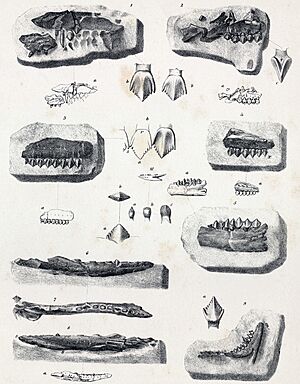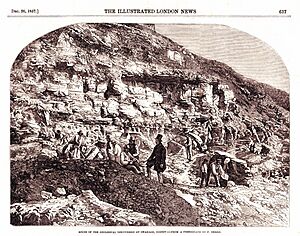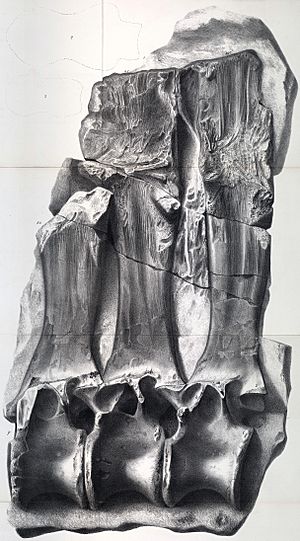Samuel Beckles facts for kids

Samuel Husbands Beckles (born April 12, 1814, in Barbados – died September 4, 1890, in Hastings, England) was a lawyer from the 1800s who became a famous dinosaur hunter. He found many ancient animal remains in Sussex and the Isle of Wight in England.
In 1854, he described bird-like footprints that he thought might have been made by dinosaurs. By 1862, he believed these tracks were likely from the dinosaur Iguanodon. In 1857, after a mammal jawbone was found at Durlston Bay, Beckles led a huge digging project called 'Beckles' Pit'. His team removed five meters of earth over a large area, making it one of the biggest scientific digs ever at the time. The many mammal fossils found there are now mostly kept at the Natural History Museum in London.
Samuel Beckles also discovered a small plant-eating dinosaur called Echinodon. The only known species, Echinodon becklesii, was named in his honor. A mammal called Plagiaulax becklesii and a dinosaur originally named Becklespinax (now known as Altispinax) were also named after him.
Early Life and New Path
Samuel Beckles was born on April 12, 1814, in Barbados. His father, John Alleyne Beckles, was an important judge there. Samuel moved to England to study law. He became a lawyer in 1838. In the same year, he married his cousin, Susannah Henry.
In 1845, Samuel Beckles stopped working as a lawyer because of health problems. He then moved to St Leonards-on-Sea in East Sussex, a place known for its fossils.
A Passion for Fossils
Even though he had health issues, Samuel Beckles spent the next 45 years collecting fossils. He wrote many articles about his discoveries for the Quarterly Journal of the Geological Society of London.
Between 1851 and 1854, he wrote about footprints found in the Wealden rocks near Hastings. These rocks are from the Lower Cretaceous period. He realized these were prints from large, two-legged animals, possibly birds. In 1854, he became a member of the Geological Society of London. By 1862, he was sure these footprints belonged to dinosaurs, especially Iguanodon.
The Famous 'Beckles' Pit'
In 1854, a mammal jawbone was found at Durlston Bay by William Brodie. Over the next two years, more discoveries were made. Richard Owen, another famous scientist, convinced Beckles to dig up the area where the jawbone was found. This big excavation started in 1856.
Beckles not only managed the dig but also paid for it himself. This project became known as 'Beckles' Pit'. They dug up a huge area, more than 600 square meters, removing five meters of dirt from the top. The important fossil layer, a type of clay called a "dirt bed," was only about 5 centimeters thick. The digging lasted for nine months and was even featured in the Illustrated London News newspaper.
From this dig, they found at least twelve different types of ancient mammals. They also found parts of reptiles, insects, and freshwater shells. In 1859, Samuel Beckles was chosen as a Fellow of the Royal Society. This was a great honor that recognized his skill and passion for his work.
The fossils found were first sent to Charles Lyell, who then gave them to Hugh Falconer to study. Lyell then sent the fossils to Owen, who published his detailed descriptions in 1871.
Samuel Beckles' first wife passed away. He married for a second time in 1882 to Jane Gordon. Samuel Beckles died on September 4, 1890.



